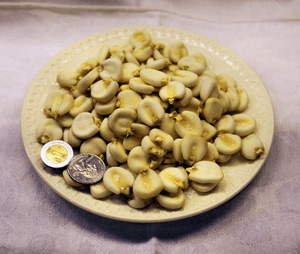Mote (food) facts for kids

Mote is a general name for different types of corn grains that have been boiled. People eat mote in many parts of South America. It's usually made by boiling the grains in water that has been made alkaline (the opposite of acidic) by adding ashes or lime. This special process is called nixtamalization.
Mote was also a very important food for Native American hunting groups and war parties when they went on long trips.
Contents
Mote in Argentina
In Argentina, people mostly eat mote in the mountainous northwest region. It's a thin stew, different from a thick soup called locro. It's made from white hominy (corn) that is sometimes peeled. It's boiled with jume ash. People often add small pieces of meat like llama, goat, or beef. You can also find it made with beans and wheat. In the northern part of Patagonia, people eat mote with a cool drink like water, juice, or soda.
Mote in Bolivia
In Bolivia, "mote" means grain that is cooked with its husk still on. Usually, it's corn, but sometimes fava beans are used. When the husk is taken off the grain, the dish is called pelado. If you just say pelado, it usually means corn. Wheat pelado is mostly used in soups.
Mote in Chile
When people in Chile say "mote," they usually mean wheat mote. This is wheat grain that has been boiled and had its husk removed, often by machines. It's mainly used to make a sweet drink called mote con huesillos. If it's salted, it's eaten with stews and sauces, in dishes like porotos con mote or papas con mote. It's also used in soups.
The Mapuche people use mote to make a type of dough called catuto. They also make a slightly alcoholic drink called muday from it. Mote is an ingredient in many other Mapuche foods, like cazuelas. Corn mote (called moteméi) is a husked corn grain used in both sweet desserts and savory foods.
Mote in Ecuador
In Ecuador, "mote" means corn kernels that have been boiled and cooked, then peeled. They are often served with popular dishes like hornado (roasted pork) and fritada (fried pork). Mote is also used in many soups, including caldo de patas (hoof soup). It's also the main ingredient in dishes famous in the city of Cuenca, such as mote pillo, mote sucio, and mote pata.
Mote in Peru
In Peru, mote refers to white corn kernels that have had their husks removed. They are boiled with charcoal or firewood, but today people use calcium hydroxide (slaked lime) powder. In Cusco, Peru, there's a special kind called giant corn mote of Cusco (maíz mote gigante del Cusco), which is known for being very large. In Peru, wheat cooked in this way is known as wheat mote (mote del trigo).
Mote in Venezuela
In Venezuela, this dish is called mute. It's made from husked white corn kernels that are boiled with ash or calcium hydroxide until they burst open completely. In central Venezuela, people add pork and spices to give the dish more flavor. In the Andes mountains, it's made with beef stomach (tripe). In the states of Lara and Yaracuy, it's made with goat organs like liver and kidneys. Corn prepared this way is also used for the arepa pelada from the state of Falcón.
See also
 In Spanish: Mote para niños
In Spanish: Mote para niños


